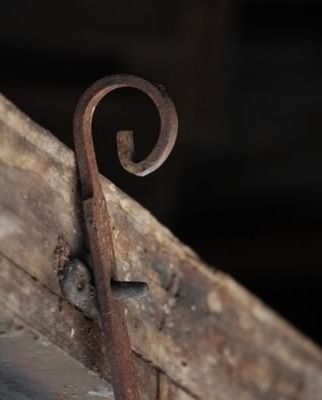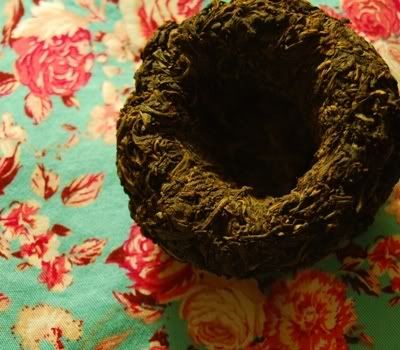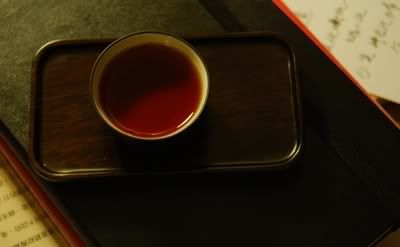I like old things, knackered things, decrepit wastrels, and dented, battered items of all kinds. There's something definitely sabi and perhaps even a little wabi about such artifacts.
So, I was fully geared up for nostalgic rapture when faced with this inexpensive tuocha from the 1990s, bought from Nadacha. At just £15, bijou alarms bells were ringing, but I silenced them soon enough.
Wrapper-less and naked, it reclined in louche fashion all pouting desirability and potential charms. However, it had absolutely no aroma of any kind.
I was taken aback by the size and integrity of the leaves, being accustomed to the usual Xiaguan-esque ubermulch from which tuocha are typically constructed. This example has some long, luxurious leaves in its blend (pictured below).
I was taken aback by the size and integrity of the leaves, being accustomed to the usual Xiaguan-esque ubermulch from which tuocha are typically constructed. This example has some long, luxurious leaves in its blend (pictured below).
Even after rinsing, the aroma is quiet - excepting whopping great big quantities of shicang [wet storehouse].
While the soup comes out a deep orange-brown, indicating that it has not reached the depth of "proper old pu'er", it looks pleasant. Concerningly, the aroma in the wenxiangbei [aroma cup] is merely... warm. Perhaps, in the distance, a little vague sweetness.
While the soup comes out a deep orange-brown, indicating that it has not reached the depth of "proper old pu'er", it looks pleasant. Concerningly, the aroma in the wenxiangbei [aroma cup] is merely... warm. Perhaps, in the distance, a little vague sweetness.
I was not conservative with the quantity of leaf, given the quietness of the dry leaves, and so the body of the tea has a thick texture. However, it is absent much in the way of charm or flavour, delivering a faint shicang sweetness - but otherwise, very little. This emptiness was quite a surprise.
As infusions passed, it did evolve into a slightly more pronounced sweetness, but I found myself having to perform extraordinarily long infusions almost from the start in order to coax much out of this reticent fellow. In order to obtain flavour, I had to begin overlapping my infusions after the fourth: letting the next brew while I enjoyed the current one.
The fifth infusion entirely blocked my filter! I didn't fair well with this tea, despite its abnormally chunky leaves (shown below).
What this tea does have is a very pleasant, calming chaqi. It soothes, hums a lullaby, and almost causes me to slide into slumber.
Fairly priced, and perhaps interesting for its chaqi, I didn't find much to excite me in this little chap. Later infusions (10+) show a roughness in the throat that didn't really endear itself to me.
This tea reminded me of tired old wet-stored maocha. Sabi only goes so far - the item has to be solid. It is a good lesson in what storage should not be: an erosion, an exhaustion, an expiration.
Fairly priced, and perhaps interesting for its chaqi, I didn't find much to excite me in this little chap. Later infusions (10+) show a roughness in the throat that didn't really endear itself to me.
This tea reminded me of tired old wet-stored maocha. Sabi only goes so far - the item has to be solid. It is a good lesson in what storage should not be: an erosion, an exhaustion, an expiration.






The leaves look too green for a 90s sheng. The colour of the tea soup looks too red for a 90s sheng. 90s tuos should not fade like that. Strange indeed.
ReplyDelete--ST
Interesting!
ReplyDeleteI have not had this tuo from Nada (it is/was actually on my to-order list), but have noticed teas from this excellent merchant to be predominantly dry-stored and very 'clean' in flavour.
Have you tried any of the older cakes recently introduced by Nada?
Best, Nerval
Dear ST,
ReplyDeleteI can't imagine a 00's tea tasting like this - it needs a few years to reach that degree of emptiness! Who knows, though. :)
Dear Nerval,
Yes, Nadacha teas can be dry-stored, too. I think Nada picks whatever he likes from those that he comes across, wet or dry. I've not delved into many of the older ones, yet, but the samples I've bought have recently arrived so look forward to doing so. I hope you'll share your opinions on them, too!
Toodlepip both,
Hobbes
I have one of these tuos and was thinking of drinking some today for the chaqi because I have a cold and can't taste anything anyway! I agree the tea is exceedingly mild. Very sweet. If you are aiming for chaqi, this is not bad for the price, though.
ReplyDeletebest,
Israel
I also bought this guy, and I agree with your comments. I thought it made a good every day aged sheng. But its not that special. It is good however.
ReplyDeleteJeremy
Dear Israel,
ReplyDeleteI wonder which tea a traditional Chinese doctor would prescribe for a cold? Something with warmth, I imagine. You might want to stay off the shengpu - not that I know very much about TCM. :)
Dear Jeremy,
True enough!
I've since had another session with this one, and realised that I neglected to mention the blend of leaves. You can see a little of it in the last photograph of the main article - some of the leaves are exceedingly dark and gnarled, much like shupu.
A friend was wondering if it might have some cooked components, and the blend I encountered provides some support for that supposition.
Either way, it's cheap and cheerful, but not one I'm rushing back to in a hurry.
Toodlepip,
Hobbes
Dear Hobbes,
ReplyDeleteYou are probably right about avoiding shengpu...However, I'm drinking this tuo and it stuck me even before I read your last comment that it has something very shu about it. From what I can taste and smell, there is a quite wet smell and taste to the leaves that reminds me of drinking some mid-aged shupus. I did not recall this from the last time I tried this tea in the fall. Quite mysterious.
cheers,
Israel
Dear Israel,
ReplyDeleteIf it looks like it has a little shupu in it, and it tastes like it has a little shupu in it... :)
Best of luck on a swift recovery.
Toodlepip,
Hobbes
I like this tea - indeed, I'm on my second tuo. The great thing for me is that it provides a window into aged pu at a very affordable price. I feel this is the whole purpose of the tea (if tea has a purpose!). I have found it a very useful education too.
ReplyDeleteIts certainly wet stored! I have managed to convince myself that the musty flavour is not musty but a cave like mineral quality. The taste of broken rocks.I have to be in the right mood, but when I am, I find it perfectly entertaining.
And that is Nada's way it seems to me. His tea is a personal selection. You're buying what he likes. And so far I like his taste.
...and BTW...
Your blog is my essential reading. Your tea reviews are proving to be a very reliable and valuable reference. Keep up the super work.
Cheers from Wrexham (N.Wales)
Dear Drumhum,
ReplyDeleteIt's true - £12 won't get you much in the way of old tea these days, so I'll take it where I can get it, similarly. :)
I happen to enjoy the shicang/wet flavour quite a bit. There's plenty of room on my shelves for all genres...
Thanks very much for the kind words - I didn't know the Half-Dipper had any Welsh readers, so welcome aboard!
Toodlepip,
Hobbes
Here here, Drumhum. Both Nada and Hobbes have been integral to my tea-learning. I thank them both.
ReplyDeletecheers,
Israel
You're far too generous, but I'm glad you're enjying the Half-Dipper nonetheless. :)
ReplyDeleteToodlepip,
Hobbes
To me this seems like such a work of art! You'll have to put a tutorial on how to brew this, I'm afraid if I bought it I would not do it right!
ReplyDeleteDear Pat,
ReplyDeleteThis one's very easy to brew, in fact - simply because one has to brew it for so long, given its emptiness. I used a little pot (maybe 7-8cl) with a lot of leaves, and it still required extremely long infusions to get much out of it.
This definitely isn't a tea that's going to punish you for getting it wrong!
Toodlepip,
Hobbes
I too own one of these tuos. I agree that the aroma is quite subtle--it never occurred to me that it might include some shu leaves, but my experience with sheng/shu combos is...nada. At this price, it's tempting to grab a couple more, wrap them, and see what a few years does to an already subtle tea.
ReplyDeleteZero
Absolutely, Zero - what's the worst that can happen? :)
ReplyDeleteToodlepip,
Hobbes
Speaking of wrapping teas that arrive "naked," as it were, does anyone have any tips for obtaining decent, scentless wrapping material?
ReplyDeleteThanks,
Israel
I just use paper bags for that kind of thing, or another tea's box if it's spare :)
ReplyDeleteToodlepip,
Hobbes
I use cheap tissue paper from supermarkets. Just the right size for wrapping a beeng.
ReplyDeleteTea folks always shout not to use paper that has been bleached. A friend who works in a museum and uses the stuff to wrap artifacts says its easy to spot bleached paper as its nearly always more shiny on one side (like many paper bags!). If you go for cheap stuff you should be safe as I suspect its the bleaching process that makes tissue paper more expensive (like the stuff from craft shops - or used for gift wrapping).
(...and sorry if there is a different name in the US for UK's "tissue paper" - I don't mean the stuff for noses or a***s.)
Gosh I've suddenly become vocal on this blog ;-)
That's a good point - you wouldn't want it to be treated in any way.
ReplyDeleteIn British English, "tissue paper" is the coloured wrapping paper, "tissues" are disposable handkerchieves, and "toilet paper" or "loo roll" refers to the medium by which one performs their ablutions. :)
Toodlepip,
Hobbes
Thank you for the lesson in British English! And thanks for the ideas. I think I have settled on a plain, brown paper sack. It is odorless, unbleached and clean. Hopefully it is not too thick to allow a bit of airflow.
ReplyDeleteAmerican english (Very much the same): "tissue paper"= colored wrapping paper, "tissue" or "Kleenex" (a brand name)= disposable handkerchief, and "toilet paper"= "ablution" roll.
cheers,
Israel